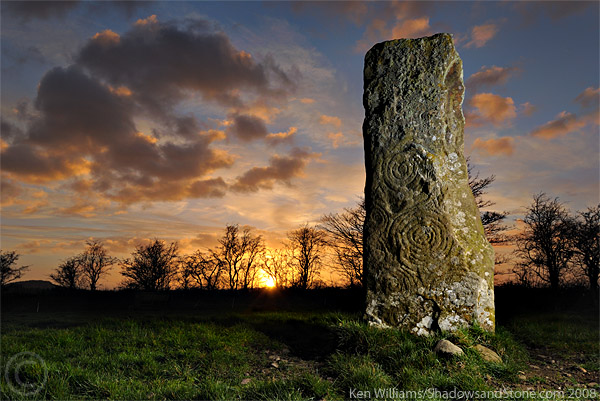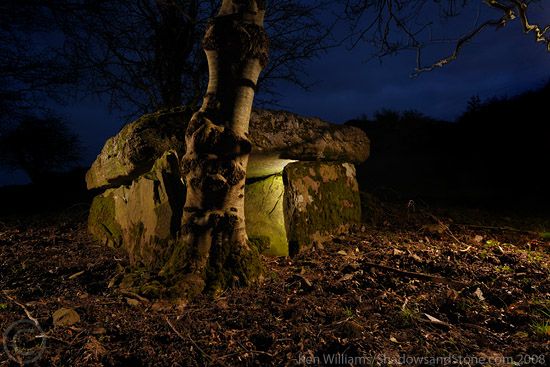
Looking out of the passage of Cairn S from the chamber with the sun about to dip below the horizon

Looking out of the passage of Cairn S from the chamber with the sun about to dip below the horizon
I set a reminder in my phone to check out this cairn at sunset around Bealtaine as Martin Brennan suggested it has an early May alignment. Well, I since switched phones so it was only while looking for a drawing of something else (the stone at Killin in Co. Louth, which he seems to have confused with Carrickrobin) that it hit me. As luck would have it, the weather then wasn’t great but tonight it was perfect.
The sunset does indeed stream down the left hand side of the passage (as looking out) and forms a rectangle of light on right side of the backstone which slowly decreases in size as the sun reaches the horizon. It may have even entered the now-destroyed right hand chamber before dipping below the horizon.

Near-Bealtaine sunset as seen from rear of chamber, as reported by Martin Brennan




Noticed these two motifs while making my way back to the car, from the middle section of the outcrop.
The Naper family have owned the remaining old estate at Loughcrew since the 1600’s but are now selling up and moving on. The sale includes the gardens and coffee shop where the key for Cairn T can be picked up off-season.
Humewood Castle is closed presently for renovations and redevelopment (though the golf resort plans are presently being appealed by An Taisce), but luckily I bumped into some people at the gatehouse and was able to venture in for some pics.
The castle is a very large Gothic revival piece from the 19th century complete with walled gardens, lakes and a very large deer park. The co-ords on archaeology.ie place the stone in the middle of a disused tennis court but after some moseying around I spotted a large slab sitting incongruously between two paths very near the castle itself.
The carvings are well worn but immediately obvious once you are close, I doubt there is any time of day or year when the low sun would naturally bring them up at their present location.
A large three ring design with external gutter dominates the panel at about 14” across, surrounded by cups with single or double rings and occasional gutters. Simple cup marks are also dotted around and at the curved top end.
The gent I spoke to (who also assisted me in taking some pics by standing in the sun!) told me it may be moved on the advice of an archaeologist because of the risk of damage being on the verge of the road, it seems to bear fairly recent scars which are thankfully on the un-carved end.
The whole stone is about a metre and a half long, larger than it appeared in previous photos I had seen. Apparently it was found buried while one of the artifical lakes was being built in the castle grounds.

With a distinctly ‘photographer-shaped’ shadow across the stone.

Two Short Lectures
by
Robert Hensey
NUI Galway
When Space and Time Collided:
A Ritualistic Perspective on the Beginnings of Astronomical Alignment in Passage Tomb Tradition
Between Salmon and Ceremony:
Seasonal Ritual in the Boyne Valley
Brú na Bóinne Visitor Centre
Wednesday June 11th 2008
7.00pm
Free of Charge

Sloping panels of very weathered carvings, eastern side of outcrop

Three shots merged to show the descent of the sun as viewed from the outcrop itself

The outcrop with Croagh Patrick in the background

Carvings on the ‘capstone’ on top of the outcrop and the sun setting into the notch at the bottom of the slope

On a Roll... The sun slowly reaches the peak of the mountain before sliding down the edge in a rather spectacular fashion 17/4/08

The ‘Doagh Island-like’ parallel grooves are more apparent in this pic, artificial or not???

The entire panel from above
This stone is now in storage in Collins Barracks in Dublin with the decorated face facing the wall.
*Important*
The landowner of this site can be very hostile to unannounced visitors, please do not attempt to visit this site without securing proper permission. Please be warned.
This is a very eroded panel on a lozenge shaped outcrop. Eight cup and ring marks are reported in the Co. Louth survey but I noticed some parallel lines that look suspiciously artificial. The whole panel is about 1.5m long and on two levels.
Description from Co. Louth Survey:
“Lozenge-shaped tabular rock outcrop, with eight cup and ring motifs. These range from a triple-ringed example to simple cup and ring. There is a much-eroded single cup and ring mark on a nearby rock outcrop. (CLAJ 1981, 111)”
On our visit on 12/4/08, the whole site was very overgrown and required quite a bit of clearing and careful removal of dead foliage before the markings became apparent. Permission was not easy to obtain, only for the fact that he remembered Blaze from her previous visit did we finally get the ok. The landowner lives on the main road, not down the lane, look for the boarded up windows and bullet holed windows and do approach with caution. Do not park near the stones blocking the driveway as he does not like this.

This stone now sits not a million miles from ‘The Witches Stone’ so I think it needs it’s own moniker. I think ‘The Alien Spore’ is quite apt.


The ‘Sundial Stone’, subject of Dr. Euan McKie’s recent lecture at the visitors centre. As you can see, some damaged or indistinct areas make the proposed 14 month calendar hypothosis a little dubious. This damaged area was imaginatively reconstructed in a book by N.L. Thomas.

Looking towards Knockmore, the piece of rock art is in a garden just past the farm sheds visible on the hill side.

The large cup and ring design on the western face with Mount Leinster in the background lit by some lovely evening light.


With some of the external and internal kerb visible

As much as an aerial view as you can get without taking flight. Shows kerb and tomb.

Carvings on an orthostat inside the ante-chamber







Get back you beast or my Daddy will be very, VERY cross...



Taken with a very wide angle lens, makes the little hollow look much larger than it is! Yes, that’s some black bin liner, you can’t see the barbed wire covering the stone I’m squatting on however.

Taken while crouched in between the pile of boulders this panel is now part of.
An Illustrated Lecture
The Prehistoric Solar Calendar:
Is Knowth the Key?
By
Dr Euan MacKie
Honorary Research Associate,
National Museums of Scotland
at
Brú na Bóinne Visitor Centre
Tuesday 25th March
7pm
Free of Charge


With the invisible man for scale

After the Rain


In the foreground is the cup with almond-shaped ring, the parallel lines are where the splash of light can be seen further up the outcrop. Looking east again.
After scouring the fields for the rock art locations on archaeology.ie for a couple of hours I slowly accepted that these panels have either become turf covered, or, more alarmingly, been blown up with dynamite like many of the outcrops on the hillside obviously have been over the past few years.
The blown up outcrops in the first field from the road have not been cleared and the remaining stone still litters the hill, this is probably not a good sign since it seems to suggest clearance or building stone was not the reason for using dynamite.
I only found these carvings after a lot of staring at outcrop. There’s definite parallel grooves enclosed by lines but these are hugely weathered now and difficult to bring out in full. I also spotted a single cup surrounded by an almond or ‘eye’ shaped ring on the same outcrop.

Some of the odd parallel lines peculiar to the Island of Doagh

Looking east towards Malin